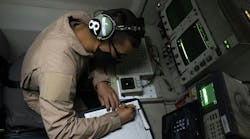Thales Communications to build radio for Army Stryker brigades
Radio designers from Thales Communications Inc. in Clarksburg, Md., won a U.S. Army contract to provide the AN/PRC-148 multiband inter/intra team radio to the U.S. Army Stryker brigades 1 and 2 located at Fort Lewis, Wash. The contract came from U.S. Special Operations Command at Mac Dill Air Force Base, Fla.
VDC analysts see steady growth in power IC shipments
Shipments of power-supply and power-management integrated circuits (ICs) should grow by 8.8 percent each year between 2003 and 2006, according to analysts at Venture Development Corp. (VDC) in Natick, Mass. The study, "The Global Market for Power Supply and Power Management Integrated Circuits," finds that combined worldwide shipments for power-supply and power-management ICs totaled nearly $5.5 billion in 2003 and should grow to nearly $7 billion 2006, VDC analysts say. Factors influencing forecasted growth include increased demand for wireless and broadband technologies, and an overall recovery in information technology hardware spending. For more information on the study contact VDC online at www.vdc-corp.com/power/annual/03/br03-14.html.
Northrop Grumman, General Dynamics to build five new submarines
Shipbuilders from Northrop Grumman Corp. and General Dynamics Corp. are set to build five Virginia-class attack submarines for the U.S. Navy under terms of an $8.4 billion contract. The companies will build the submarines in Newport News, Va. The contract replaces the six-ship block-buy contract announced on Aug. 14, 2003. The new contract enables both builders to leverage economies of scale by purchasing materials, parts, and components for several ships at one time. The contract also includes the construction of a sixth Virginia-class submarine that was authorized in fiscal year 2003.
Smiths moves ahead with F-35 electrical power management system design
Electronics designers at Smiths Aerospace in Cheltenham, England, are moving ahead with developing the system supporting the F-35 more-electric architecture after passing a critical design review. The review validates design approaches and allows the hardware and software commissioning to proceed, company officials say. The EPMS will control and distribute primary, secondary, and battery power at 28 volts DC, 270 volts DC, and 115 volts AC for the future Lockheed Martin F-35 Joint Strike Fighter.
Air Force Rome lab chooses Alphatech for sensor-fusion work
Leaders of the U.S. Air Force Research Laboratory (AFRL) Information Directorate in Rome, N.Y., are choosing Alphatech Inc. of Burlington, Mass., to develop an integrated air-picture integration resource center to support system architect and modeling efforts. Work on the Single Integrated Air Picture (SIAP) Program is under terms of a nearly $2 million contract, which comes under supervision of the Air Force Electronic Systems Center (ESC) at Hanscom Air Force Base, Mass. The new computer software and hardware will integrate several platforms and provide an enhanced modeling capability for Air Force programs.
Lansdale wins missile components contract from Raytheon
Engineers at Lansdale Semiconductor Inc. in Tempe, Ariz., won a contract from Raytheon in Lexington, Mass., to produce replacement electronic components for the Patriot air and missile defense system. Lansdale will build custom bipolar integrated circuits (ICs) flux drivers, and Darlington transistors. The drivers and transistors are for the Patriot's critical multifunction on-board phased array radar system, which carries out search, target detection, track and identification, missile tracing and guidance, and electronic counter-countermeasures functions, Lansdale officials say. The radar, which has a 62-mile range and can track as many as 100 targets, is mounted on a trailer and receives instructions from the digital weapons control computer in the Engagement Control Station, via a cable link. The radar can provide missile guidance data for as many as nine missiles. For more information go online at www.lansdale.com.
Performance Technologies to acquire Mapletree Networks
Electronics-subsystems designer Performance Technologies in Rochester, N.Y., will acquire Mapletree Networks of Norwood, Mass., which specializes in digital signal processing (DSP) products for voice-over Internet Protocol (VoIP). Mapletree Networks will become an operating unit of Performance Technologies, and will help Performance provide platform configurations to original-equipment manufacturers (OEMs) and system integrators, company officials say. Mapletree develops voice, data, and fax systems with DSP and RISC processors. The core of Mapletree's technology is the UniPorte Software Architecture, which helps develop IP-based communications network equipment.
Tundra Semiconductor demonstrates VME-to-PCI/X bus bridge
Designers at Tundra Semiconductor Corp. in Ottawa, demonstrated 2eSST VME bus technology using the Tundra Tsi148 VME-to-PCI/X bus bridge. The Tsi148 implements the 2eSST protocol, which boosts VME bus throughput to as fast as 320 megabytes per second. The Tsi148 provides an increase in overall processing capability on relatively old backplanes, while transparently enabling high-performance distributed processing, Tundra officials say. The Tsi148 bridges PCI or PCI-X on the local bus to the VMEbus. It eliminates performance bottlenecks by operating as a peer with other devices on the local bus. This can reduce the total number of bridges that VMEbus product vendors and end users in the military, industrial automation, and communications need for bandwidth management on the host card. For more information contact Stacey Diffin-Lafleur at Tundra Semiconductor by phone at 613-592-0714, ext. 1820, by e-mail at [email protected], or online at www.tundra.com.
Northrop Grumman to modernize military health information systems
Engineers at the Northrop Grumman Corp. Information Technology (IT) sector in Herndon, Va., are helping to upgrade several U.S. Department of Defense health information systems. This effort is part of the Defense Medical Information Systems/Systems Integration, Design, Development, Operations, and Maintenance Services III (D/SIDDOMS III) program. Northrop Grumman and other companies will bid to provide information systems for the Military Health System, TRICARE Management Activity, and the Department of Veterans Affairs. For more information see www.it.northropgrumman.com/index.
Elisra IR missile-warning system may protect Israeli F-16s
Tests have shown that the PAWS-2 infrared-based missile warning system from Elisra Group in Bnei Brak, Israel, is effective in protecting F-16 jet fighters, company officials say. PAWS-2 demonstrated its ability to detect and track targets uses algorithms, image, and signall processing, officials say. By tracking the missile's trajectory, PAWS discriminates between threatening and nonthreatening missiles. When it detects a threatening missile, PAWS-2 automatically alerts the pilot, activates countermeasures, and provides information to directed infrared countermeasures. PAWS-2 also provides threat information to other electronic warfare (EW) systems as part of an EW suite, as well as to avionics subsystems.
SI International wins Air Force Space Command contract
Officials at SI International Inc. in Reston, Va., will provide ballistic missile defense (BMD) engineering and technical services to the U.S. Air Force Space Command (AFSPC) in Colorado Springs, Colo. SI International provides information technology and network solutions primarily to the federal government. More information about SI International is available at www.si-intl.com.
XAware teams with Lockheed Martin on E-rulemaking project
XAware Inc. in Colorado Springs, Colo., is providing data-integration software to the Lockheed Martin Information Technology business unit in Seabrook, Md., in a project establish a common, automated, and integrated approach to managing the federal government's rulemaking functions. Lockheed Martin will build the government-wide portal and develop automated tools for rulemaking writers and docket managers at more than 150 federal agencies. XAware Inc. will provide support software to enable participating agencies to connect to a wide variety of systems, including mainframes, databases, flat files, custom applications, and vendor-specific application packages.
German airline chooses cockpit door–monitoring system from Hapag Floyd
Hapag Lloyd Fluggesellschaft, a German airline company and part of TUI AG, chose FlightVu Cockpit Door Monitoring Systems (CDMS) for its fleet of 29 Boeing 737-800s. AD Aerospace of Manchester, England, and Aircraft Engineering & Installation Services Inc. (AEI) of Orlando, Fla., are providing the video security system and installation design respectively. The FlightVu CDMS system enables the flight crew to monitor the area outside the flight-deck door and adjacent galleys without leaving their seats. The FlightVu CDMS consists of three closed-circuit television (CCTV) cameras linked to a liquid-crystal display. Infrared illuminators help provide images even with the cabin lights extinguished. For more information visit www.ad-aero.com.
Elbit subsidiary EFW to build data-entry system for F-16 aircraft
Officials of the Elbit subsidiary EFW Inc. of Fort Worth, Texas, won a $32.6 million contract from the U.S. Air Force's Ogden Air Logistics Center to provide 694 Common Data Entry Electronics Units (CDEEUs) that act as interfaces between pilot entry and cockpits displays. EFW engineers will build another 609 for foreign military sales. This effort supports the Improved Item Replacement Program for the F-16 preblock 40 aircraft. The CDEEU was developed by EFW as part of Air Force's Common Configuration Implementation Program for the F-16 C/D, under which Lockheed Martin is providing avionics improvements for the Block 40 and 50 F-16 aircraft.
Lockheed Martin to help study comets in the solar system
Engineers at the Lockheed Martin Advanced Technology Center (ATC) in Palo Alto, Calif., built key components for ROSINA — the Rosetta Orbiter Spectrometer for Ion and Neutral Analysis — an instrument on the European Space Agency's (ESA) Rosetta spacecraft. The goal of the international mission is to rendezvous, orbit, and land on Comet 67P/Churyumov-Gerasimenko in 2014, in an effort to answer questions about the origin of our solar system. ROSINA will perform composition analysis on the Rosetta mission with a mass spectrometer that uses electric and magnetic fields to map the mass of an ion to its chemical composition. The highest resolution mass spectrometer ever flown, ROSINA will measure the isotopes Carbon 12 and Carbon 13, which differ by a single neutron, and are used in carbon dating to determine the ages of organisms, Lockheed Martin officials say. The ATC is a unit of Lockheed Martin Space Systems Co.


